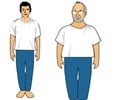
Is Muscle Dysmorphia Prevalent Among Young Men?
Analyzing over 2,000 participants, from the Canadian Study of Adolescent Health Behaviors, researchers found that adolescent boys and young adult men had many muscle dysmorphia symptoms, and one in four was at clinical risk for muscle dysmorphia.‘Boys and men striving for a muscular body are experiencing psychological and social distress as a result of muscle dysmorphia.’
Tweet it Now
Moreover, muscle dysmorphia symptoms were more common in those who reported anabolic-androgenic steroid use, which is highly effective, yet dangerous, illicit substances that can increase muscle mass and tone.The study also highlighted unique disparities across sexual identities and racial/ethnic groups. Compared to participants who identified as White, those who identified as South Asian or Middle Eastern were more likely to have greater muscle dysmorphia symptoms.
Additionally, participants who identified as a sexual minority (i.e., gay, lesbian, bisexual, etc.), compared to heterosexual participants, were more likely to experience greater muscle dysmorphia symptoms.
Raising Awareness for Muscle Dysmorphia
These findings emphasize that many young people are striving for muscularity, resulting in significant levels of distress. This counters popular narratives that only thinness-oriented body image concerns and behaviors are problematic.Therefore, we need to incorporate muscle dysmorphia symptoms into future conversations around body image and eating disorders, particularly given the likely rise as a result of the COVID-19 pandemic.
Advertisement
Advertisement









